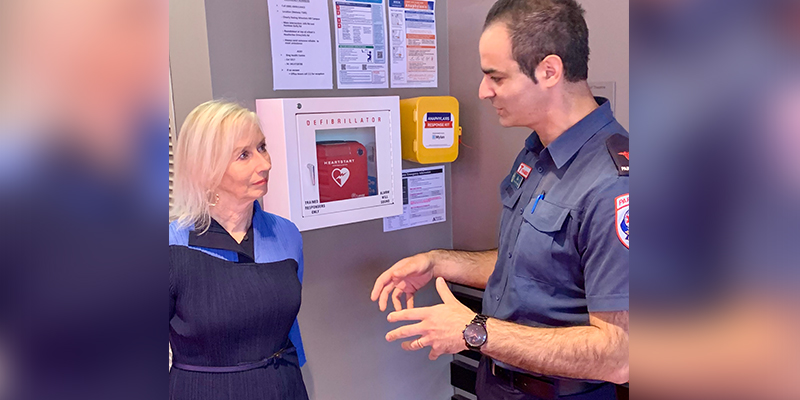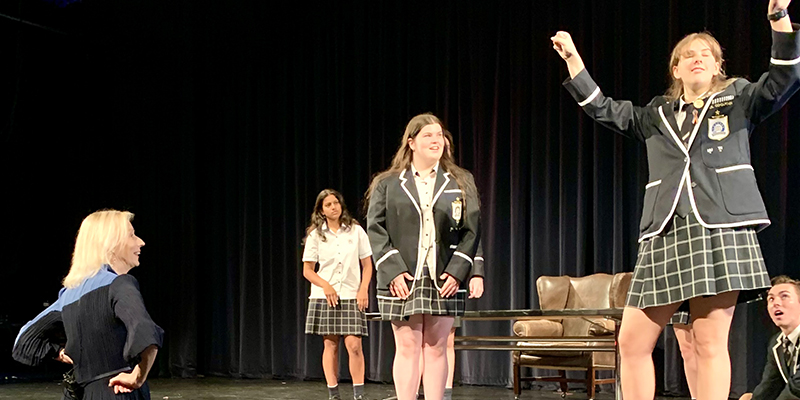More bystanders than ever are using publicly accessible automated external defibrillators (AED) to help Victorians in cardiac arrest, according to data released by Ambulance Victoria (AV).
The latest Victorian Ambulance Cardiac Arrest Registry (VACAR) Annual Report revealed paramedics responded to a record 7,830 out-of-hospital cardiac arrests in 2022/23, up 6.4 per cent from the previous year.
Of those cases, 139 had a shock delivered from a public AED, the highest number on record and up from 107 cases last year.

Caulfield Grammar School Drama Teacher and cardiac arrest survivor Lyndy Clarke (left) and AV Director Research and Evaluation Ziad Nehme (right).
AV Director of Research and Evaluation, Ziad Nehme said for over two decades VACAR has been providing valuable insights into out-of-hospital cardiac arrests.
“Out-of-hospital cardiac arrest is one the leading causes of death worldwide and a significant public health issue in Australia,” he said.
“Data from the most recent VACAR report reinforces why Victoria has the best cardiac survival rates in Australia, and among the best in the world.
“When cardiac arrests were witnessed by members of the public, 80 per cent of people were willing to step up and commence lifesaving cardiopulmonary resuscitation (CPR) – a vital step in the chain of survival.
“There was also a record number of people using AEDs, with 53 per cent of patients surviving their cardiac arrest after receiving a shock before paramedics arrived.”
In September last year, Melbourne drama teacher Lyndy Clarke experienced first-hand the lifesaving impact of bystander CPR and AEDs, after she collapsed while directing a play at Caulfield Grammar School.
Luckily for Lyndy, her colleague, Pete Tserbis witnessed the incident and instantly retrieved a nearby AED and started CPR.
“I knew immediately from her limp body and no response from talking to her or squeezing her hands that it was serious,” Pete said.
“Had I not been trained in CPR, I would have found myself in a situation without the skills to help Lyndy. I couldn’t imagine having stood there and done nothing.”
The 68-year-old received three shocks from the AED before paramedics arrived and transported her to hospital.
“It came completely out of the blue. I was fit and healthy and had no signs or symptoms of heart issues,” Lyndy said.
“The last thing I remember is getting up to give a direction and then I was waking up in the hospital 24 hours later.”

Lyndy directing a school play.
As fate would have it, Lyndy was the one who lobbied for the AED that saved her life, after she witnessed someone go into cardiac arrest at a school performance over 10 years ago.
Lyndy said that incident opened her eyes to the importance of learning CPR and how to use an AED – the two very skills that saved her life.
“If the defib had not been in the foyer outside the auditorium, I would have died,” she said.
“People always assume they’ll never need to help someone in cardiac arrest but my advice is; learn these lifesaving skills and be aware of your nearest AED.”
Pete said he felt extreme relief knowing he was able to save his colleague and friend of 15 years.
“Knowing what to do, and how to take action in that moment has been the greatest gift that has kept my friend and mentor from taking her final bow,” he said.
“This incident proved that you never know a scenario where you will need CPR.”
Every day, around 20 Victorians suffer a cardiac arrest but only one in 10 survive.
Minutes matter and when a patient receives CPR and a shock from an AED before paramedics arrive, their chance of survival more than doubles.
AV MICA Paramedic Brett Meyer said his team’s clinical care on scene was aided by bystander intervention, which gave Lyndy the best chance of survival.
“Those moments between collapse and paramedics arriving are vital, and we’re pleased that bystanders did everything they could to make sure Lyndy was in the best possible position to be revived by our team,” he said.
“For every minute CPR is delayed, survival decreases by 10 per cent. Our message is simple – you don’t need to be a paramedic to save a life, just remember to Call (Triple Zero 000), Push (Perform CPR) and Shock (use an AED).”
After a week in hospital and months of rehabilitation, Lyndy has returned to work and says she continues to feel healthier every day.
She is now a member of the Shock Squad, a group of cardiac arrest survivors brought together by Community First Responders Australia.
Lyndy aims to increase awareness about bystander intervention and has signed up to be a GoodSAM responder.
GoodSAM is a mobile app that connects patients in cardiac arrest with a nearby volunteer who is willing to start hands-only CPR while paramedics are on their way.
Last year saw AV release its 2023-2028 Cardiac Arrest Improvement Strategy which aims to improve community-based participation in CPR and public access defibrillation.
“AV’s vision is to improve cardiac arrest survival rates in Victoria by 30 per cent by 2028,” Ziad said.
“Some initiatives in the strategy include investing in community education programs (including education in schools) and Heart Safe Communities, as well as encouraging the use of digital media applications, such as GoodSAM, to enhance community responses.”
The Cardiac Arrest Improvement Strategy underpins AV’s organisation-wide culture of excellence in out-of-hospital cardiac arrest care.
To see the full VACAR 2022-2023 report, visit the website.








